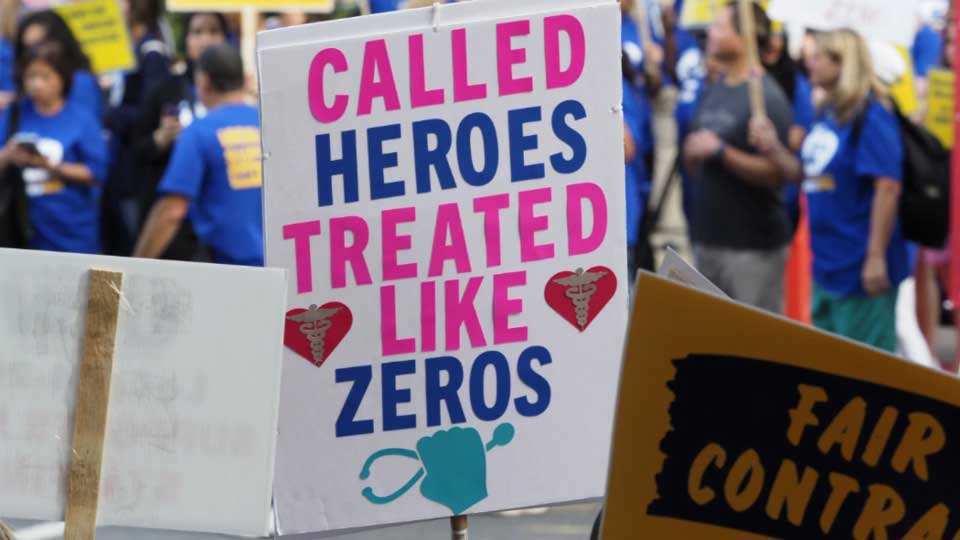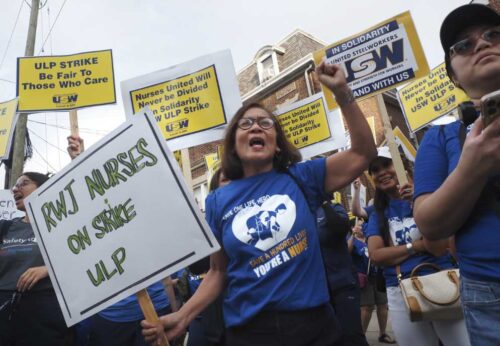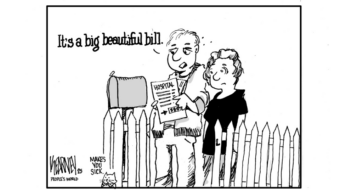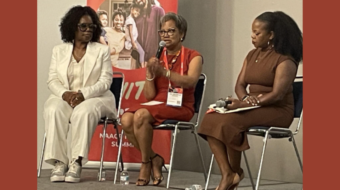
NEW BRUNSWICK, N.J.—1,700 nurses have been on strike for eight weeks at the Robert Wood Johnson hospital complex in New Brunswick, New Jersey. In May, Rutgers University faculty went on strike with the support of the Robert Wood Johnson doctors and nurses. The faculty strike was fought against an administration which had compelled staff to work without a contract for nearly a year and had threatened to get an injunction to break the pickets. Now, the faculty are coming out to show they’ve got the nurses’ backs in their struggle.
On Sept. 12, the nurses’ negotiating team returned to the bargaining table for the first time in a month. Earlier, the union had issued this statement:
“Management rejected our most recent proposal, and we are still waiting for a counterproposal from the hospital. Our talks primarily centered on staffing, and our bargaining committee continues to work to explore a number of options that adequately address staffing and enforce ratios.
“We have been clear throughout this process that it’s essential to have staffing ratios that account for acuity and help stave off burnout,” the message continued. “We have been unable to move the hospital on this issue since we began bargaining.”
Union activists have pointed to the serious effects of understaffing on both the nurses and their patients—burnout and high turnover among nurses, both of which have negative impacts on the treatment of patients.
Judy Daniella, a staff nurse at Robert Wood Johnson for 28 years and the president of USW Local 2-400 representing the nurses, said it best: “It’s time to sit down, have healthy negotiations, and get a contract for the nurses that have been out here with us every day. We need to put these nurses back to work and get rid of the scab nurses that are inside”
Labor’s call: Who’s listening and who’s answering
The union has called for its members and supporters to push the leaders of the Democratic Party at the state and local level to stand with the union in demanding serious negotiations and a fair contract. There have been statements of support, and Congressman Nat Pallone, who has long represented the New Brunswick area, walked the picket in solidarity with the nurses with other Democratic Party officials. But that alone means little without serious action.

So far, the union and its supporters have been frustrated with Gov. Phil Murphy, who has done little while calling the failure to negotiate “unacceptable” and hailing the nurses as “heroes” and New Jersey as a strong “labor state.”
The larger questions remain: What is to be done, and what should be done? Daniella, the nurses’ leader, answered that question forcefully when she said of the Democratic leadership: “They’ll come speak at our rally, but they won’t put their name behind the safe-staffing bill in the state of New Jersey. It’s time for them to do that. It’s time for Murphy to say, ‘Look, what are we doing here?’”
Earlier in the strike, Sen. Bernie Sanders, I-Vt., who chairs the Senate Health, Education, Labor, and Pensions Committee, sent a letter to hospital President and CEO Mark Manigan expressing solidarity with the striking nurses and urging the hospital’s leadership to negotiate in good faith with the union and reach a fair contract agreement.
“This is your opportunity to do the right thing and work with your employees to improve your hospital for workers and patients,” Sanders wrote. In his proposals in the Senate over the years, he has sponsored legislation to both protect and empower workers and trade unionists.
Strike context
The faculty strike victory at Rutgers University was made possible in part by Murphy’s intervention to prevent the Rutgers administration from carrying out their threat to seek an injunction to break the strike and by his using the influence of the state to direct negotiations toward a positive settlement.
The faculty union is now strongly backing the nurses’ strike, which is directly connected with Rutgers. The Johnson and Johnson company has long been dominant in shaping the development of New Brunswick, often with the active support of Rutgers. It is a powerful transnational corporation with a long history of undermining workers’ rights. In 2016, Robert Wood Johnson Medical School merged with RJ Barnabas, the largest healthcare provider in New Jersey.
The doctors and nurses stood with the faculty in their successful strike, but Robert Wood Johnson/RJ Barnabas has learned from that struggle. It has spent $54 million for “replacement workers,” a.k.a. scabs, who are far less efficient in providing care than the striking nurses.
Barnabas lists itself as a “not-for-profit organization” to limit federal taxes, but its total revenue last year was over $6 billion. Its former CEO, Barry Osrtrosky, left office last year with a $22 million bonus. The present CEO, Mark Manigan, is a member of the Rutgers Board of Governors, which is the peak of the university’s top-down power structure. None of the Board members are elected, and faculty, staff, and students have no access to the board’s private deliberations, much less its voting power.
What can and should be done now
If Gov. Murphy is serious about supporting the nurses, he should intervene now to advance mediation and a settlement, as he did in the faculty strike. The Democratic majority in the state legislature should enact, and Murphy should sign, the safe staffing bill that the union and the nurses have called for.
New Jersey residents should demand the RWJ/Barnabas executives immediately end their denial of medical insurance to these essential workers, an outrageous form of intimidation which it launched on Sept. 1. A fair contract must be negotiated as soon as possible so that the 1,700 nurses can return to work.










